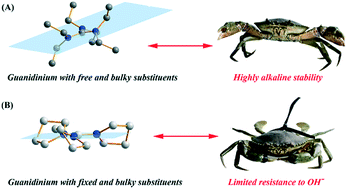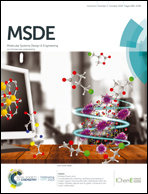Highly stable polysulfone anion exchange membranes incorporated with bulky alkyl substituted guanidinium cations†
Abstract
A series of guanidinium-based cations with various N-substituted groups (methyl, ethyl, isopropyl, cyclobutyl, benzyl and phenyl) were synthesized and their alkaline stabilities were evaluated by 1H NMR analysis. The results indicated that the contribution of the substituent group toward the stability followed the sequences: isopropyl > ethyl > benzyl > phenyl and ethyl > methyl > cyclobutyl. The relative stability sequences suggested that free and bulky alkyl substituent groups with large steric hindrance can dramatically improve the alkaline stability. Tetraethyl-benzyl-isopropyl guanidinium showed the highest alkaline stability which remained unchanged after treatment with 1 mol L−1 KOH/CD3OD at 60 °C for 312 h. Novel polysulfone anion exchange membranes (AEMs) with such stable guanidinium cations were prepared via iridium-catalyzed C–H activation and the Suzuki–Miyaura reaction. The obtained guanidinium functionalized AEM exhibited excellent resistance to alkaline solutions (after immersing in 1 mol L−1 NaOH at 60 °C for 30 days, no degradation was observed), indicating that AEMs functionalized by guanidiniums with large steric hindrance are very promising materials for AEM applications.



 Please wait while we load your content...
Please wait while we load your content...